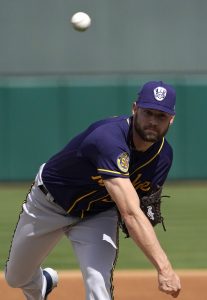Travis Shaw can opt out of his minor league contract with the Brewers tomorrow but it seems very likely that the team will include Shaw on its Opening Day roster, according to Tom Haudricourt and Todd Rosiak of the Milwaukee Journal Sentinel. Officially selecting Shaw’s contract would guarantee the veteran a $1.5MM salary for the coming season, and the Brewers would have to make another corresponding move to open up a 40-man roster spot. The left-handed hitting Shaw is expected to get the bulk of playing time at third base when a right-hander is on the mound, with Orlando Arcia, Daniel Robertson, and (if not at shortstop) Luis Urias all getting at-bats against southpaws.
More from the city of Giannis, Liberace, Laverne and Shirley…
- Today’s Cactus League game with the Mariners saw both Derek Fisher and Adrian Houser leave early due to injury. According to the Brewers’ official announcement, “left hamstring discomfort” forced Fisher from the game after he scored from first base on a double, and manager Craig Counsell told Haudricourt and other reporters that Fisher will be out of action for a while. The out-of-options Fisher was already facing some tough competition to win a roster job, and this injury setback could further hamper if not ruin his chances. As for Houser, he left the game with right thumb discomfort, but both the hurler and Counsell felt it was a minor issue that shouldn’t much interrupt Houser’s preseason preparations.
- In other injury news, Lorenzo Cain is expected to make his Spring Training debut by the weekend, Counsell told The Athletic’s Will Sammon and other reporters. After opting out of much of the 2020 season, Cain’s return to the field has been slowed by a quad injury. It remains to be seen how much time Cain will need to ramp up for the season, so an injured list placement probably still isn’t out of the question for at least the first week of the schedule.
- Right-hander Ray Black will begin throwing off a mound by the end of the week, Counsell said, as Black will return to work after being shut down due to elbow inflammation. The hard-throwing Black tossed only three innings over three games in 2020, missing much of the season due to a strain in his right rotator cuff. Given his recent injury history, Black could very well be an IL candidate for Opening Day.
